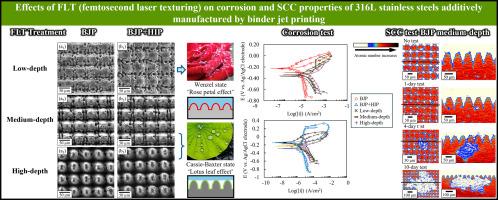Effects of femtosecond laser texturing on the corrosion and stress corrosion cracking resistances of the 316L austenitic stainless steel additively manufactured by binder jet printing
IF 9.3
1区 材料科学
Q1 MATERIALS SCIENCE, MULTIDISCIPLINARY
引用次数: 0
Abstract
The impact of femtosecond laser texturing (FLT) on the corrosion and stress corrosion cracking (SCC) behavior of binder jet printed (BJP) 316L stainless steel, both in its as-printed form and after hot isostatic pressing (HIP), is investigated. Hierarchical micro- and nano-surface architectures were produced using FLT through 200, 400, and 800 laser passes, corresponding to low-, medium-, and high-depth textures, respectively. The latter two resulted in superhydrophobic surfaces, while the low-depth texture imparted superhydrophobicity to BJP 316L but only hydrophobicity to BJP+HIP 316L. Compared to the low-depth textures, the medium- and high-depth textures significantly reduced the adhesion of corrosive media. Cyclic potentiodynamic polarization tests showed that FLT enhanced localized corrosion resistance in BJP 316L but diminished it in BJP+HIP 316L. Corrosion rates correlated directly with increasing surface roughness, following the order 200 < 400 < 800 passes. Crucially, medium-depth FLT markedly improved SCC resistance in BJP 316L. Post-FLT, the SCC performance of BJP 316L matched that of their HIP-treated counterparts. These findings demonstrate that FLT is a promising post-processing strategy to bolster both localized corrosion and SCC resistance in additively manufactured 316L stainless steel.

飞秒激光织构对喷印316L奥氏体不锈钢增材耐腐蚀和应力腐蚀开裂性能的影响
研究了飞秒激光织构(FLT)对粘结剂喷射打印(BJP) 316L不锈钢在打印状态和热等静压(HIP)后腐蚀和应力腐蚀开裂(SCC)行为的影响。使用FLT通过200、400和800次激光通道分别对应于低、中和高深度纹理,产生了层次微和纳米表面结构。后两者形成超疏水表面,而低深度织构赋予BJP 316L超疏水性,但只赋予BJP+HIP 316L疏水性。与低深度织构相比,中深度和高深度织构显著降低了腐蚀介质的附着力。循环动电位极化试验表明,FLT增强了BJP 316L的局部耐蚀性,而降低了BJP+HIP 316L的局部耐蚀性。腐蚀速率与表面粗糙度的增加直接相关,顺序为200 <; 400 <; 800次。关键是,中深度FLT显著提高了BJP 316L的SCC抗性。在flt后,BJP 316L的SCC表现与他们的髋关节治疗对手相当。这些发现表明,FLT是一种很有前途的后处理策略,可以增强增材制造316L不锈钢的局部腐蚀和抗SCC能力。
本文章由计算机程序翻译,如有差异,请以英文原文为准。
求助全文
约1分钟内获得全文
求助全文
来源期刊

Acta Materialia
工程技术-材料科学:综合
CiteScore
16.10
自引率
8.50%
发文量
801
审稿时长
53 days
期刊介绍:
Acta Materialia serves as a platform for publishing full-length, original papers and commissioned overviews that contribute to a profound understanding of the correlation between the processing, structure, and properties of inorganic materials. The journal seeks papers with high impact potential or those that significantly propel the field forward. The scope includes the atomic and molecular arrangements, chemical and electronic structures, and microstructure of materials, focusing on their mechanical or functional behavior across all length scales, including nanostructures.
 求助内容:
求助内容: 应助结果提醒方式:
应助结果提醒方式:


